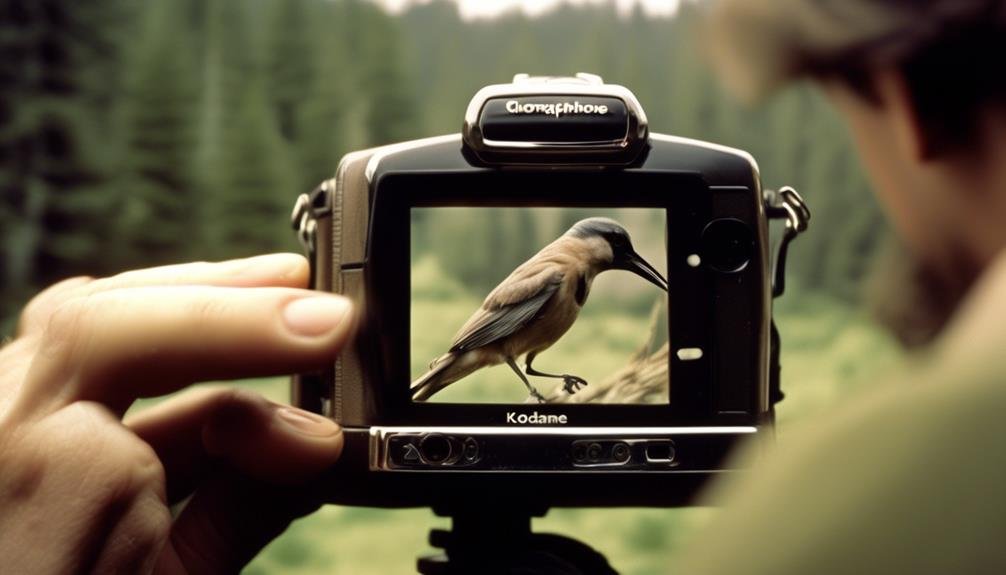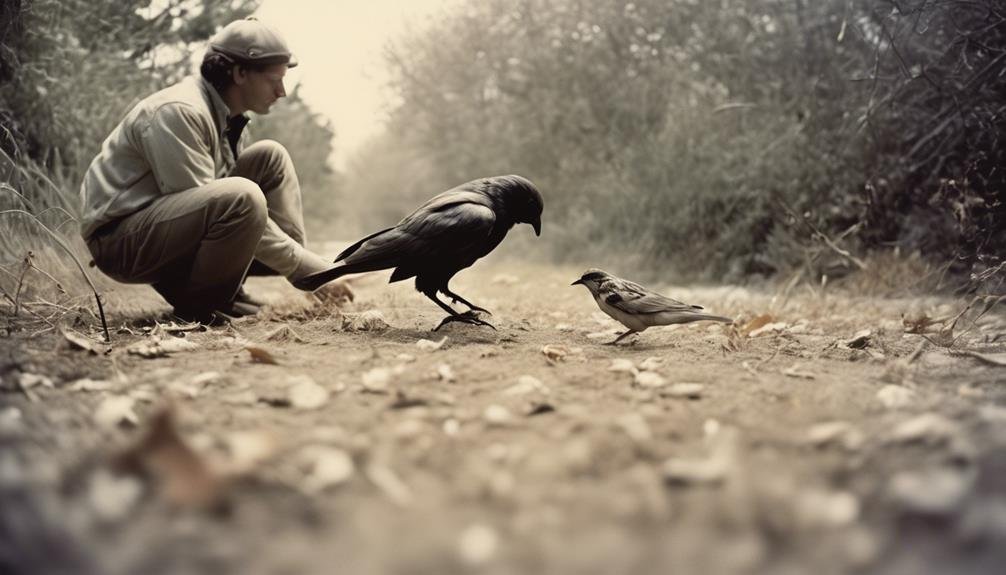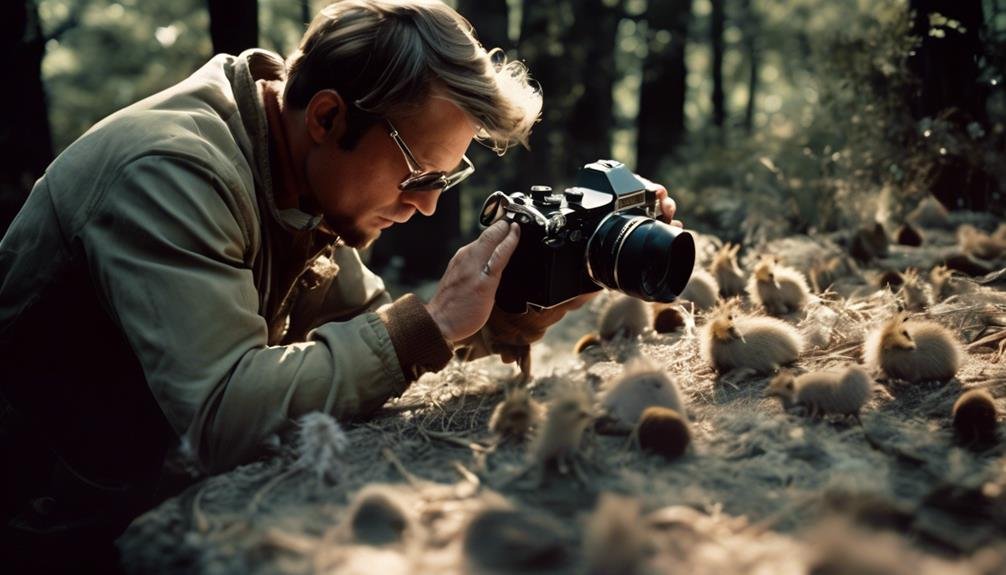
As wildlife photographers, we all strive to capture those breathtaking moments in the natural world. But when it comes to using mirrorless cameras for wildlife photography, there are specific techniques and tricks that can truly elevate our images. From understanding wildlife behavior to mastering autofocus techniques, there's a wealth of knowledge to be gained in order to truly excel in this field. Whether you're a seasoned pro or just starting out, these expert tips will help you elevate your wildlife photography game to the next level. So, let's uncover the secrets that can turn an ordinary wildlife shot into an extraordinary masterpiece.
Understanding Wildlife Behavior
Understanding wildlife behavior is crucial for capturing stunning wildlife photographs with mirrorless cameras. By delving into the world of wildlife tracking and animal communication, we can gain a deeper insight into the habits and movements of different species. Wildlife tracking involves studying animal footprints, droppings, and other signs to understand their behavior and movement patterns. This knowledge allows photographers to anticipate where the animals may be, increasing the likelihood of capturing compelling shots.
Furthermore, understanding animal communication is key to predicting their actions and reactions. Animals communicate through various vocalizations, body language, and even scent markings. By interpreting these signals, photographers can anticipate when an animal might display interesting behavior, such as hunting, grooming, or interacting with their offspring.
Ultimately, this understanding of wildlife behavior enables photographers to position themselves strategically, adjust camera settings, and be ready to capture those decisive moments in the wild. It's not just about being in the right place at the right time; it's about knowing why it's the right place and the right time.
Selecting the Right Lens
When capturing wildlife photographs with mirrorless cameras, it's crucial to carefully select the right lens to ensure sharp, detailed shots that truly capture the essence of the animals in their natural habitat. Lens selection is key in wildlife photography as it directly impacts the quality and composition of your shots. When photographing in diverse wildlife habitats, it's essential to consider the environmental impact and the focusing techniques required for each setting. For wide, open spaces, a telephoto lens with a longer focal length is ideal for capturing animals from a distance without disturbing them in their natural environment. However, in dense forests or smaller habitats, a shorter focal length lens with a wider aperture may be more suitable for maneuverability and capturing subjects up close. Understanding the impact of different lenses on the environment and the ability to adjust focus quickly and accurately are critical components in selecting the right lens for wildlife photography with mirrorless cameras.
Mastering Autofocus Techniques

To master autofocus techniques in wildlife photography with mirrorless cameras, we need to familiarize ourselves with the different autofocus modes and understand their applications in capturing dynamic wildlife subjects. When it comes to focus tracking, it's essential to use continuous autofocus mode to keep moving subjects in sharp focus. Additionally, understanding how to utilize single-point autofocus can help maintain precise focus on a specific area of the subject, such as the eyes of a bird or the face of a mammal. In low light situations, utilizing autofocus modes that are designed to perform well in such conditions, like low-light autofocus or manual focus assist, can significantly improve the quality of the shots. Moreover, learning how to customize autofocus settings and utilizing features such as eye and animal detection can enhance the accuracy and speed of autofocus performance in capturing wildlife moments.
- Continuous autofocus for focus tracking
- Single-point autofocus for precision
- Low-light autofocus mode for dim environments
- Customizing autofocus settings for improved performance
Utilizing Burst Mode for Action Shots
When capturing wildlife in action, utilizing burst mode can make all the difference in getting that perfect shot. Understanding the benefits of burst mode, adjusting settings for fast-moving subjects, and mastering timing and composition are essential for successful action shots. We'll explore how to maximize the potential of burst mode to capture stunning wildlife moments with your mirrorless camera.
Burst Mode Benefits
Capturing wildlife in action can be challenging, but utilizing burst mode on a mirrorless camera can significantly improve the chances of getting that perfect shot. When it comes to action shots, burst mode offers several benefits:
- High Shutter Speed: Burst mode allows for capturing multiple frames in quick succession, increasing the likelihood of getting a sharp image even in fast-paced wildlife scenarios.
- Dynamic Movement: It enables the photographer to capture the dynamic movement of wildlife, ensuring that no crucial moment is missed.
- Variety of Poses: Burst mode provides a range of shots to choose from, ensuring that the best pose or expression is captured.
- Precise Timing: It helps in achieving precise timing, especially for fast and unpredictable movements of wildlife, resulting in stunning and impactful photographs.
Settings for Action
Utilizing burst mode for action shots on a mirrorless camera optimizes the settings for capturing dynamic wildlife movements with precision and impact. When it comes to action photography, especially in wildlife, fast-paced shots are essential for capturing motion. To achieve this, adjusting the camera settings is crucial. Here are some recommended settings for capturing action shots:
| Settings | Description |
|---|---|
| Shutter Speed | Increase shutter speed to freeze motion. |
| Aperture | Use a wide aperture for a shallow depth of field. |
| ISO | Adjust ISO to maintain proper exposure in fast-changing light conditions. |
| Continuous AF | Enable continuous autofocus to track moving subjects. |
| Burst Mode | Utilize high-speed burst mode to capture a series of shots in quick succession. |
Timing and Composition
As we explore the intricacies of timing and composition in wildlife photography with mirrorless cameras, we can harness the power of burst mode to seize the perfect action shots. When utilizing burst mode for action shots, consider the following techniques:
- Lighting Techniques: Experiment with different lighting conditions to capture the most dynamic and visually striking action shots.
- Framing Techniques: Use framing to draw attention to the subject and create a sense of immediacy and excitement in action shots.
- Creating Depth: Incorporate depth into your compositions to give a three-dimensional feel to the action, making the viewer feel like they are right in the middle of the wildlife action.
- Leading Lines: Utilize leading lines to guide the viewer's eye through the image and directly toward the action, creating a sense of movement and energy.
Composing Dynamic Wildlife Portraits
When capturing dynamic wildlife portraits, we need to consider the rule of thirds, background selection, and subject interaction. The rule of thirds helps to create balanced and visually appealing compositions by placing the subject off-center. Carefully choosing the background can make the subject stand out and convey a sense of its natural habitat, while capturing the subject's interaction with its environment adds depth and emotion to the photograph.
Rule of Thirds
To capture dynamic wildlife portraits, it's essential to understand and apply the rule of thirds in your photography composition. The rule of thirds involves dividing the image into nine equal parts using two horizontal and two vertical lines, positioning the most important elements along these lines or their intersections to create a balanced and visually appealing composition. Here are some tips to effectively apply the rule of thirds in wildlife photography:
- Subject Placement: Position the main subject, such as an animal or bird, at the intersections of the grid to draw attention and create visual interest.
- Negative Space: Utilize the rule of thirds to incorporate negative space around the wildlife subject, emphasizing its presence and environment.
- Leading Lines: Use the grid lines to align leading lines, like branches or foliage, to guide the viewer's eye towards the main subject.
- Horizontal Alignment: Align the horizon with one of the horizontal lines to establish a sense of balance and harmony in the composition.
Background Selection
Understanding the impact of background selection on wildlife photography composition is crucial for capturing compelling and dynamic portraits of animals in their natural habitats, building on the foundation of the rule of thirds for creating visually captivating images. When selecting nature-inspired backgrounds, consider using a variety of creative framing techniques to add depth and interest to your wildlife portraits. By incorporating these techniques, you can elevate your photography by capturing the essence of the animal's environment while ensuring it remains the focal point of the image. Here's a table to illustrate some nature-inspired backgrounds and creative framing techniques:
| Nature-Inspired Backgrounds | Creative Framing Techniques |
|---|---|
| Forest canopy | Framing with foliage |
| Mountain range | Using leading lines |
| Water reflections | Framing with natural elements |
| Sunset skies | Silhouetting the subject |
| Desert landscapes | Utilizing negative space |
Subject Interaction
In capturing dynamic wildlife portraits, we aim to convey the interaction between the subject and its environment, highlighting the natural behaviors and unique characteristics of the animal. When it comes to subject interaction in wildlife photography, ethical considerations and wildlife photography etiquette are paramount. Here are some key points to consider:
- Respect the Animal: Always prioritize the well-being and comfort of the animal when capturing its interactions. Avoid disrupting natural behaviors or habitats.
- Observe from a Distance: Use long lenses and maintain a respectful distance to capture genuine, unobtrusive interactions without causing distress to the subject.
- Patience is Key: Allow the subject to acclimate to your presence, capturing authentic interactions without forcing the situation.
- Environmental Integration: Showcase the subject's interaction with its natural surroundings, emphasizing the harmony between the animal and its environment.
Managing Exposure in Challenging Conditions
Capturing wildlife in challenging lighting conditions requires careful consideration of exposure settings to ensure the subject is well-lit and the background remains balanced. When faced with tricky lighting, long exposure techniques can be employed to capture stunning images. However, this requires a thorough understanding of exposure compensation and metering modes to achieve the desired results.
| Exposure Compensation | Metering Modes |
|---|---|
| Adjusts overall exposure to brighten or darken the image | Evaluative Metering: Considers the entire frame for exposure |
| Useful for compensating for bright or dark subjects | Spot Metering: Measures a specific area, useful for high contrast scenes |
| Can help in maintaining details in highlights and shadows | Center-Weighted Metering: Emphasizes the center of the frame for exposure |
| Allows for creative control over the final image | Partial Metering: Similar to spot metering but covers a slightly larger area |
Using Silent Shutter Features

Using the silent shutter feature in wildlife photography allows for capturing images without disturbing the natural behavior of the subject. This feature is particularly beneficial when photographing skittish or easily startled animals. Here are some key points to consider when using the silent shutter feature:
- Motion capture: The silent shutter allows for discreet shooting, making it easier to capture animals in motion without startling them. This is especially useful for photographing birds in flight or fast-moving wildlife.
- Low light performance: In low light conditions, such as during dawn or dusk, the silent shutter feature helps to minimize disturbance while still capturing high-quality images. This is crucial for maintaining the natural ambiance of the environment and ensuring good exposure in challenging lighting situations.
- Stealthy approach: With the silent shutter, photographers can take a stealthier approach, getting closer to their subjects without causing disturbance. This can result in more intimate and natural-looking wildlife photographs.
- Behavioral authenticity: By using the silent shutter, photographers can capture genuine and unaltered behaviors of wildlife without interrupting their natural activities. This is essential for documenting authentic moments in the wild.
Incorporating the silent shutter feature into wildlife photography not only respects the animals' natural environment but also allows for the capture of stunning, authentic images.
Maximizing Battery Life in the Field
Let's talk about maximizing battery life in the field to ensure we capture those amazing wildlife shots without interruption. We'll explore power-saving techniques that can help us make the most out of every charge, as well as portable charging options that keep us shooting for longer periods. By implementing these strategies, we can focus on our photography and immerse ourselves in the beauty of the natural world, knowing our gear is ready to capture those perfect moments.
Power-Saving Techniques
To extend the battery life of your mirrorless camera during wildlife photography excursions, it is essential to employ power-saving techniques that optimize performance and ensure prolonged shooting opportunities in the field. Here are some effective power-saving techniques:
- Use Airplane Mode: Activating airplane mode disables wireless functions, conserving battery power.
- Adjust Screen Brightness: Lowering the screen brightness reduces power consumption.
- Utilize Silent Shooting Mode: Silent shooting reduces the noise and vibration, which can save power.
- Carry Portable Charging Options: Invest in portable chargers or extra batteries to keep your gear powered up on the go.
Portable Charging Options
As we focus on maximizing battery life in the field, it's crucial to consider portable charging options as a seamless way to ensure extended shooting opportunities while utilizing power-saving techniques. When it comes to portable power, having a reliable solar charger can be a game-changer for wildlife photographers. Solar chargers harness the power of the sun to keep your camera batteries topped up, providing a sustainable and environmentally friendly charging solution. Look for lightweight and portable solar chargers that can easily be attached to your backpack or camera bag, ensuring that you can recharge your gear on the go. Additionally, some solar chargers come with built-in power banks, allowing you to store energy for later use, even when the sun isn't shining. This innovative approach to charging offers photographers the freedom to stay out in the field for longer, capturing those perfect wildlife moments without worrying about running out of power.
Post-Processing Tips for Wildlife Images

When post-processing wildlife images, it's essential to enhance the natural beauty of the subject while maintaining the authenticity of the scene. Here are some key techniques for post-processing wildlife images:
- Enhancing Details: Focus on bringing out the intricate details of feathers, fur, or scales to highlight the unique characteristics of the wildlife subject.
- Color Correction: Adjust the color balance and saturation to ensure that the natural hues of the wildlife are accurately represented, enhancing the overall visual impact of the image.
- Sharpening: Use selective sharpening techniques to emphasize the fine textures and features of the wildlife subject, enhancing the overall clarity of the image.
- Noise Reduction: Employ noise reduction tools to minimize any digital noise present in the image, especially in low-light or high-ISO wildlife photography situations, ensuring a clean and professional look.
Respecting Wildlife and Their Habitats
Respecting wildlife and their habitats requires a deep understanding of the natural environment and a commitment to preserving the authenticity of wildlife photography while safeguarding the well-being of the subjects. Responsible photography is key to ensuring that our presence does not disturb the natural behaviors of the wildlife we aim to capture. It's important to adhere to ethical practices, such as maintaining a safe distance from the animals and avoiding any actions that could disrupt their daily routines. Additionally, habitat preservation is crucial for the long-term survival of these species. By being mindful of our impact on the environment, we can contribute to wildlife conservation and ecosystem protection. When photographing wildlife, it's essential to minimize our footprint and prioritize the well-being of the animals and their habitats. Through our responsible and ethical approach to wildlife photography, we can not only capture stunning images but also play a part in preserving the natural world for future generations to enjoy.
Frequently Asked Questions
How Do I Effectively Camouflage Myself to Get Closer to Wildlife for a Shot Without Disturbing Them?
We can effectively camouflage ourselves to get closer to wildlife for a shot without disturbing them by using natural materials from the surroundings and carefully observing wildlife behavior. Camouflage techniques must blend seamlessly with the environment.
Are There Any Specific Mirrorless Camera Settings That Are Particularly Useful for Wildlife Photography?
We've found that camera focus, exposure settings, and lens choice are key. Tracking moving wildlife, use continuous autofocus. Adjust exposure settings for dynamic lighting. A telephoto lens offers the best reach for wildlife behavior shots.
What Are the Best Practices for Capturing Images of Nocturnal Wildlife With a Mirrorless Camera?
Capturing nocturnal wildlife with a mirrorless camera requires mastering low light techniques. We adjust settings for optimal exposure and focus on wildlife composition. Utilizing long exposures and high ISO settings, we ensure stunning nocturnal wildlife imagery.
Can You Provide Tips for Capturing Wildlife in Motion, Such as Birds in Flight, With a Mirrorless Camera?
Capturing wildlife in motion with a mirrorless camera requires patience and technique. Understanding wildlife behavior is crucial for anticipating action shots. We've honed our skills to freeze dynamic moments, delivering captivating, innovative images.
How Can I Maintain the Durability and Weather Resistance of My Mirrorless Camera While Shooting in Challenging Outdoor Conditions?
We ensure our mirrorless camera's durability and weather resistance by using cleaning techniques and moisture protection. Lens covers shield from impact, and we prioritize impact resistance for the camera body. These measures safeguard our gear in challenging outdoor conditions.
